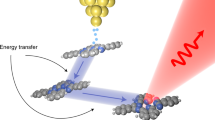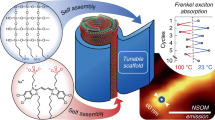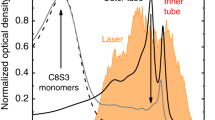Abstract
Supramolecular assemblies that interact with light have recently garnered much interest as well-defined nanoscale materials for electronic excitation energy collection and transport. However, to control such complex systems it is essential to understand how their various parts interact and whether these interactions result in coherently shared excited states (excitons) or in diffusive energy transport between them. Here, we address this by studying a model system consisting of two concentric cylindrical dye aggregates in a light-harvesting nanotube. Through selective chemistry we are able to unambiguously determine the supramolecular origin of the observed excitonic transitions. These results required the development of a new theoretical model of the supramolecular structure of the assembly. Our results demonstrate that the two cylinders of the nanotube have distinct spectral responses and are best described as two separate, weakly coupled excitonic systems. Understanding such interactions is critical to the control of energy transfer on a molecular scale, a goal in various applications ranging from artificial photosynthesis to molecular electronics.
This is a preview of subscription content, access via your institution
Access options
Subscribe to this journal
Receive 12 print issues and online access
$259.00 per year
only $21.58 per issue
Buy this article
- Purchase on Springer Link
- Instant access to full article PDF
Prices may be subject to local taxes which are calculated during checkout





Similar content being viewed by others
References
Scholes, G. D., Fleming, G. R., Olaya-Castro, A. & van Grondelle, R. Lessons from nature about solar light harvesting. Nature Chem. 3, 763–774 (2011).
Cantekin, S., Balkenende, D. W. R., Smulders, M. M. J., Palmans, A. R. A. & Meijer, E. W. The effect of isotopic substitution on the chirality of a self-assembled helix. Nature Chem. 3, 42–46 (2011).
Hofmann, C. C. et al. The influence of π–π-stacking on the light-harvesting properties of perylene bisimide antennas that are covalently linked to a [60]fullerene. Phys. Chem. Chem. Phys. 12, 14485–14491 (2010).
van Dijk, L., Bobbert, P. A. & Spano, F. C. Extreme sensitivity of circular dichroism to long-range excitonic couplings in helical supramolecular assemblies. J. Phys. Chem. B 2, 817–825 (2010).
Zhang, X., Rehm, S., Safont-Sempere, M. M. & Würthner, F. Vesicular perylene dye nanocapsules as supramolecular fluorescent pH sensor systems. Nature Chem. 1, 623–629 (2009).
Brédas, J. L. & Silbey, R. J. Excitons surf along conjugated polymer chains. Science 16, 348–349 (2009).
Beljonne, D., Curutchet, C., Scholes & Silbey, R. J. Beyond Förster resonance energy transfer in biological and nanoscale systems. J. Phys. Chem. B 113, 6583–6599 (2009).
Röger, C., Miloslavina, Y., Brunner, D., Holzwarth, A. R. & Würthner, F. Self-assembled zinc chlorin rod antennae powered by peripheral light-harvesting chromophores. J. Am. Chem. Soc. 130, 5929–5939 (2008).
Kaiser, T. E., Wang, H., Stepanenko, V. & Würthner, F. Supramolecular construction of fluorescent J-aggregates based on hydrogen-bonded perylene dyes. Angew. Chem. Int. Ed. 46, 5541–5544 (2007).
Spano, F. C., Meskers, S. C. J., Hennebicq, E. & Beljonne, D. Probing excitation delocalization in supramolecular chiral stacks by means of circularly polarized light: experiment and modeling. J. Am. Chem. Soc. 129, 7044–7054 (2007).
Yamamoto, Y. et al. Photoconductive coaxial nanotubes of molecularly connected electron donor and acceptor layers. Science 314, 1761–1764 (2006).
Scholes, G. D. & Rumbles, G. Excitons in nanoscale systems. Nature Mater. 5, 683–696 (2006).
Beljonne, D. et al. Excitation migration along oligophenylenevinylene-based chiral stacks: delocalization effects on transport dynamics. J. Phys. Chem. B 109, 10594–10604 (2005).
Hoeben, F. J. M., Jonkheijm, P., Meijer, E. W. & Schenning, A. P. H. J. About supramolecular assemblies of π-conjugated systems. Chem. Rev. 105, 1491–1546 (2005).
Lang, E., Sorokin, A., Drechsler, M., Malyukin, Y. V. & Köhler, J. Optical spectroscopy on individual amphi-PIC J-aggregates. Nano Lett. 5, 2635–2640 (2005).
Brédas, J. L., Beljonne, D., Coropceanu, V. & Cornil, J. Charge-transfer and energy-transfer processes in π-conjugated oligomers and polymers: a molecular picture. Chem. Rev. 104, 4971–5003 (2004).
Hofmann, C. et al. Single-molecule study of the electronic couplings in a circular array of molecules: light-harvesting-2 complex from Rhodospirillum molischianum. Phys. Rev. Lett. 90, 1–4 (2003).
De Rossi, U. et al. Control of the J-aggregation phenomenon by variation of the N-alkyl-substituents. Journal für Praktische Chemie/Chemiker-Zeitung 337, 203–208 (1995).
Pšenčik, J., Ma, Y.-Z., Arellano, J. B., Hala, J. & Gillbro, T. Excitation energy transfer dynamics and excited-state structure in chlorosomes of chlorobium phaeobacteroides. Biophys. J. 84, 1161–1179 (2003).
Oostergetel, G. T. et al. Long-range organization of bacteriochlorophyll in chlorosomes of Chlorobium tepidum investigated by cryo-electron microscopy. FEBS Lett. 581, 5435–5439 (2007).
Balaban, T. S. Tailoring porphyrins and chlorins for self-assembly in biomimetic artificial antenna systems. Acc. Chem. Res. 38, 612–623 (2005).
von Berlepsch, H., Kirstein, S., Hania, R., Pugzlys A. & Böttcher, C. Modification of the nanoscale structure of the J-aggregate of a sulfonate-substituted amphiphilic carbocyanine dye through incorporation of surface-active additives. J. Phys. Chem. B 111, 1701–1711 (2007).
Eisele, D. M., Knoester, J., Kirstein, S., Rabe, J. P. & Vanden Bout, D. A. Uniform exciton fluorescence from individual molecular nanotubes immobilized on solid substrates. Nature Nanotech. 4, 658–663 (2009).
Lyon, J. L. et al. Spectroelectrochemical investigation of double-walled tubular J-aggregates of amphiphilic cyanine dyes. J. Phys. Chem. C 112, 1260–1268 (2008).
Cone, C. W. et al. Singular value decomposition analysis of spectroelectrochemical redox chemistry in supramolecular dye nanotubes. J. Phys. Chem. C 115, 14978–14987 (2011).
Eisele, D. M. et al. Photoinitiated growth of sub-7 nm silver nanowires within a chemically active organic nanotubular template. J. Am. Chem. Soc. 132, 2104–2105 (2010).
Frenkel, J. On the transformation of light into heat in solids II. Phys. Rev. 37, 1276–1294 (1931).
Jelley, E. E. Spectral absorption and fluorescence of dyes in the molecular state. Nature 138, 1009–1010 (1936).
Scheibe, G. Über die Veränderlichkeit der Absorptionsspektren in Lösung und die Nebenvalenzen als ihre Ursache. Angew. Chem. 50, 212–219 (1937).
Eisfeld, A. & Briggs, J. S., The J-band of organic dyes: lineshape and coherence length. Chem. Phys. 281, 61–70 (2002).
Didraga, C., Klugkist, J. A. & Knoester, J. Optical properties of helical cylindrical molecular aggregates: the homogeneous limit. J. Phys. Chem. B 106, 11474–11486 (2002).
Didraga, C. & Knoester, J. Excitons in tubular molecular aggregates. J. Lumin. 110, 239–245 (2004).
Augulis, R., Pugžlys, A. & van Loosdrecht, P. H. M. Exciton dynamics in molecular aggregates. Phys. Status Solidi C 3, 3400–3403 (2006).
Pugžlys, A. et al. Temperature-dependent relaxation of excitons in tubular molecular aggregates: fluorescence decay and Stokes shift. J. Phys. Chem. B 110, 20268–20276 (2006).
Didraga, C. et al. Structure, spectroscopy, and microscopic model of tubular carbocyanine dye aggregates. J. Phys. Chem. B 108, 14976–14985 (2004).
Knoester, J. Modeling the optical properties of excitons in linear and tubular J-aggregates. Int. J. Photoenergy 2006, 1–11 (2006).
Weber, C. M. et al. Graphene-based optically transparent electrodes for spectroelectrochemistry in the UV–vis region. Small 5, 184–189 (2010).
Sperling, J. et al. Excitons and disorder in molecular nanotubes: a 2D electronic spectroscopy study and first comparison to a microscopic model. J. Phys. Chem. A 114, 8179–8189 (2010).
Milota, F., Sperling, J., Nemeth, A. & Kauffmann, H. F. Two-dimensional electronic photon echoes of a double band J-aggregate: quantum oscillatory motion versus exciton relaxation: excited state dynamics in light harvesting materials. Chem. Phys. 357, 45–53 (2009).
Milota, F. et al. Excitonic couplings and interband energy transfer in a double-wall molecular aggregate imaged by coherent two-dimensional electronic spectroscopy. J. Chem. Phys. 131, 054510 (2009).
Womick, J. M., Miller, S. A. & Moran, A. M. Probing the dynamics of intraband electronic coherences in cylindrical molecular aggregates. J. Phys. Chem. A 113, 6587–6598 (2009).
Womick, J. M., Miller, S. A. & Moran, A. M. Correlated exciton fluctuations in cylindrical molecular aggregates. J. Phys. Chem. B 113, 6630–6639 (2009).
Brand, L. & Johnson, M. L. Methods in Enzymology: Numerical Computer Methods Vol. 210 (Academic Press, 1992).
Prokhorenko, V. I., Steensgaard, D. B. & Holzwarth, A. R. Exciton theory for supramolecular chlorosomal aggregates: 1. Aggregate size dependence of the linear spectra. Biophys. J. 85, 3173–3186 (2003).
Acknowledgements
The authors thank H. von Berlepsch and C. Böttcher for the cryoTEM images, S. Kirstein, C. M. Weber, E. Poblenz and M. Glaz for helpful discussions and laboratory assistance and A. Stradomska and V. A. Malyshev for helpful discussions. This work was supported by the Deutsche Forschungsgemeinschaft (Sfb 448 and Sfb 951), the Integrative Research Institute for the Sciences IRIS Adlershof (Berlin), the National Science Foundation (CHE-1012790), the Alexander von Humboldt-Foundation; D.M.E., S.M.V., R.J.S., M.G.B. were partially supported as part of the DOE Center for Excitonics (an Energy Frontiers Research Center funded by the US Department of Energy, Office of Science, Office of Basic Energy Sciences, DE-SC0001088), an ARO grant (W911NF-09-0480) and a DARPA grant (N66001-10-1-4063).
Author information
Authors and Affiliations
Contributions
J.P.R., D.A.V.B., J.K. and D.M.E. developed the project. D.M.E. performed experiments and data analysis, put results into perspective, and initiated the collaborations. E.A.B., S.M.V. and C.v.d.K designed the theoretical model with guidance from J.K. E.A.B. analysed the theoretical model and performed the fit to the experimental spectra, supervised by J.K. C.W.C. performed SVD analysis under the guidance of D.A.V.B. R.J.S. and M.G.B. provided helpful discussions and beneficial interpretation of the data analysis. D.M.E., E.A.B., S.M.V., J.K., M.G.B. and D.A.V.B. co-wrote the paper, with input from the other authors.
Corresponding authors
Ethics declarations
Competing interests
The authors declare no competing financial interests.
Supplementary information
Supplementary information
Supplementary information (PDF 704 kb)
Rights and permissions
About this article
Cite this article
Eisele, D., Cone, C., Bloemsma, E. et al. Utilizing redox-chemistry to elucidate the nature of exciton transitions in supramolecular dye nanotubes. Nature Chem 4, 655–662 (2012). https://doi.org/10.1038/nchem.1380
Received:
Accepted:
Published:
Issue Date:
DOI: https://doi.org/10.1038/nchem.1380
This article is cited by
-
Assembly of highly efficient aqueous light-harvesting system from sequence-defined peptoids for cytosolic microRNA detection
Nano Research (2024)
-
Second quantization of many-body dispersion interactions for chemical and biological systems
Nature Communications (2023)
-
Cryogenic TEM imaging of artificial light harvesting complexes outside equilibrium
Scientific Reports (2022)
-
Frenkel excitons in heat-stressed supramolecular nanocomposites enabled by tunable cage-like scaffolding
Nature Chemistry (2020)
-
Individual tubular J-aggregates stabilized and stiffened by silica encapsulation
Colloid and Polymer Science (2020)



